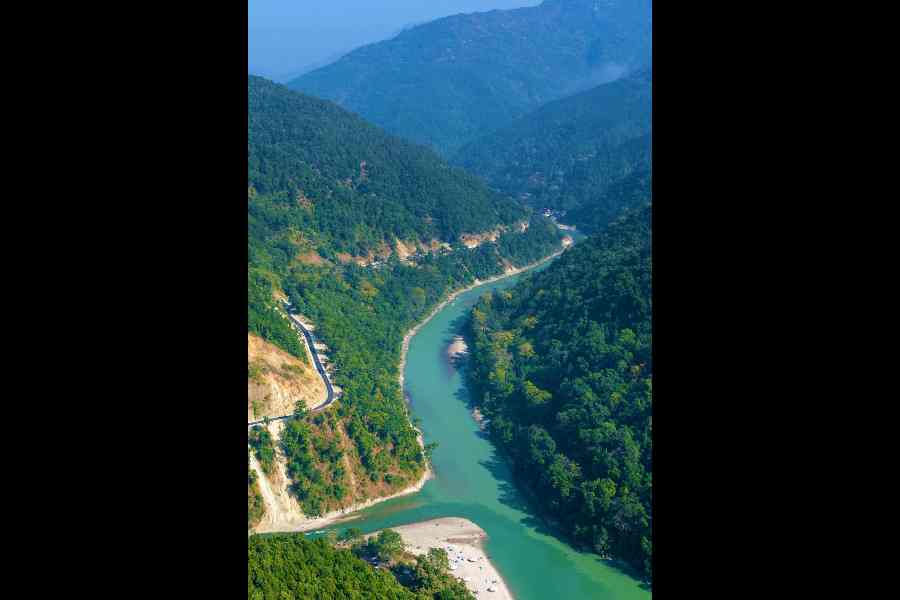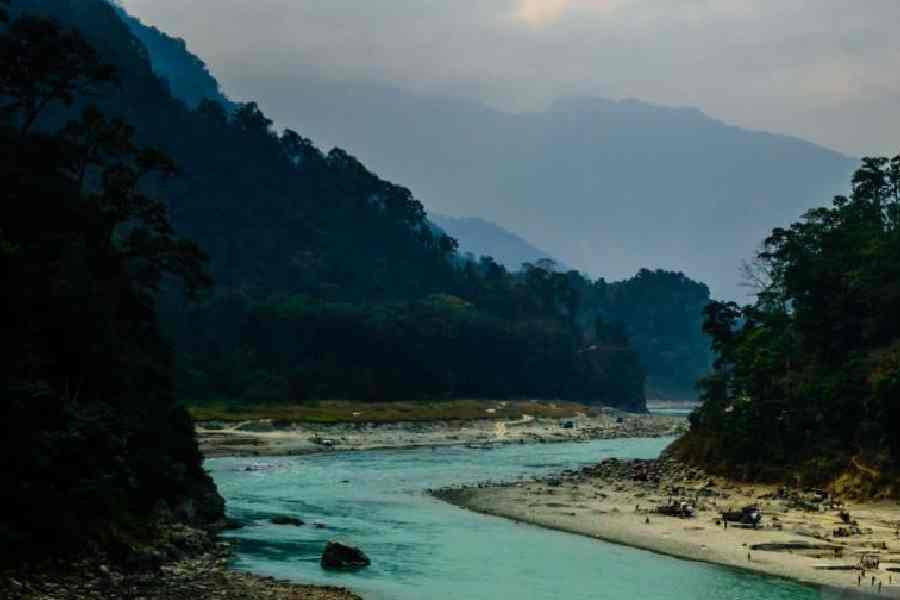I am Teesta. Not Setalvad mind you, who is uncompromising. But Teesta from the hills. Of Sikkim. Who two countries fight over but none cares for. Who has bought into the trend of stacked jewellery, only hers are more restrictive than ornamental. Who has begun to meander where she used to rush. Who has quietly put up with all the indignities she has been subjected to. And who recently, spectacularly, lost her temper.
Yes, I am that Teesta. The one who washed away in 10 minutes flat a ₹ 25,000 crore dam in Sikkim that humans spent years building, inundated a powerplant that was just beginning to turn a profit, wiped out an army camp and about a hundred lives. I wasn’t being vengeful, I was just trying to breathe, to quench my thirst. It’s not easy having a stack of dams and barrages across you, you know, not to count the Barakhata Barrage in Bangladesh.
Everyone knows what the cons of large dams are, so they built a cascade of small ones on me. A cascade of all the small cons have snowballed into major issues. The first thing is that I can hardly breathe. Freely flowing water is my essence but the dams have slowed my flow, decreasing my oxygen content and silting up the river bed. As I find less place to flow, I spread outwards, broadening myself at the cost of mountains and forests and, eventually, roads and railway tracks.
Talking of rail tracks, the all-important rail bridge that connects the Northeast to the rest of the country — the Sevoke Railway Bridge, better known as Lohapul — spans me too. It is one of the 10 main bridges crossing my breadth. The Coronation Bridge at Sevoke is the oldest one (1941), the bridge at Jalpaiguri is the all-important road link to the Northeast, while the Joyee Setu in Jalpaiguri is the longest bridge in West Bengal. All important ones and none that I washed away, please note. My intentions are not to harm, but if you don’t leave me an easy way out...
Take the dam at Chungthang that is no more. It started operating in 2017, but as early as 2005 there were concerns about its viability. There were questionable design changes in 2008 and a report in 2015 pointed out that the dam was not equipped to handle a GLOF or glacier overflow flash flood, the very thing that washed it away.
Perhaps the dam would have survived if the lock gates could have been opened on time, if there was an early warning system in place at the South Lhonak Lake that breached its banks after a cloudburst. Not that it was unexpected, the lake had grown 2.5 times in the last three decades fed by glaciers melting over time due to global warming.
But planning is not our strong point, neither is consistency. The first steps for an early warning system were taken in 2021 but then the enthusiasm petered out. As did the protests and warnings about the ill-planned, rock-filled concrete dam. The dam at Rambi Bazaar in Kalimpong survived the onslaught because that one is solid and gave the swiftly-moving flood waters a way out, something called a spillway. Recently, the powerhouse at another flood-damaged dam was destroyed too but that one isn’t really my doing.
How do I know so much, you ask. Well, people talk and in the silence of the mountains, sounds travel great distances over water.
And for much of the year, the chattering does not stop. For I am that Teesta, the brimful jade-green one who accompanies you on the journey to Gangtok. Winding sinuously through the mountains, greeting you at every turn, shimmering with the sun on its surface, running parallel to the road you take and under every bridge you cross. This year, of course, it is the road less taken, what with it being shut down for multiple days every month even during peak tourist season.
The sad truth is that there may soon come a day when the NH10 is no longer motorable. Turning it over to the National Highway Authority won’t help either because what ails it is not lack of maintenance. What ails it, is me.
And if something is not done soon to treat me, I may end up gobbling up the ground beneath the national highway’s foundation. The debris of the broken dam and other flood detritus and that from rain-induced landslides has choked me. It is now piled up six feet high on my riverbed, giving me little space. One heavy shower and I flow dangerously high.

Portrait view of lovers point where the river coming from left is Rangeet and meeting Teesta which is coming straight down. Top view of the confluences.
In fact, in Kalimpong’s Teesta Bazaar — where the river rafting route starts — I often overflow my banks and trespass into houses built close to me. Another cloudburst and I may lose control again. I am now a disaster waiting to happen. Thunderous clouds make me ripple with worry. Look what happened in Bangladesh.
Do you know why I flow green? Not because I’m jealous of Ganga. I cut off ties with her and leaned into the Brahmaputra after another fit of temper. It led to the devastating floods of 1758. I flow green because of all the fine stone particles I carry; the powdered dolomite and sandstone give the waters a blue-green tinge. And the surrounding forests too lend me their colour. Especially along that stretch where I am most sedate — from Rambi Bazaar to Kalijhora, the area between the two dams where my waters rest. Some people tell a story of special algae too, one that gives me my distinctive colour, but not many scientists like this story.
I don’t know about the colour of the water but I do know that I cradle liquid gold. Yes, it hampers my breathing, my flow, but the silt I bear is fertile, so fertile that it produces rich crops with hardly any effort. That is why groups of displaced farmers in West Bengal have settled close to my banks to grow vegetables. Neither fear of marauding elephants from the adjoining reserve forest nor strict forest guards have been able to keep them away. But too much of anything is bad and that is true of silt too. It will have to be removed to give me space to breathe. The river bed will have to be desilted, but that costs money. I hear ₹600 crore will be needed to desilt just the stretch in Gajoldoba in Jalpaiguri district that leads to the barrage.
Money, which the West Bengal government has asked for, from the Centre.
Money that was not mentioned in this year’s budget. Oh, there was money to “manage” me, but it went to the Sikkim government. Even if money were forthcoming, desilting me will be a tricky issue. Especially in Sikkim because there is little experience with desilting mountainous rivers. It is the ones that flow on flat land that get this treatment.
And even if the experts come and manage to declog my lungs, Bangladesh may still not get the water it is demanding. There was a time, they say, I brought 5,000 cusecs of water in the dry period between December and May. They want a number close to it; now they get 500. Not enough for farming and definitely not enough for fishermen. But back then, there were no dams. And the fishermen in West Bengal too are getting very little fish from me.
The dams have disrupted their spawning grounds and habits; species like the boroli — finger-length silvery fish — are decreasing every day. Fish like chitol that once populated my waters have gone missing. And so have the birds that flock to Gajoldoba. Some stay with me through the year and some come visit me in winter. This year, with the floods having washed away most aquatic life these birds feed on — fish and algae, frogs and snakes — the birds at Gajoldoba have reached a 25-year low, both in terms of headcount and species.
Yet I soldier on, dreaming of better days. In the past and, hopefully, in the future. “For if dreams die/Life is a broken-winged bird/That cannot fly”. Or an abused, silted river that has run dry.










